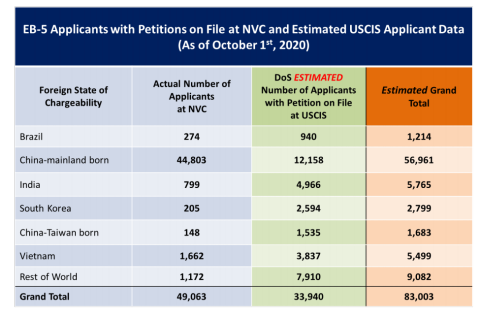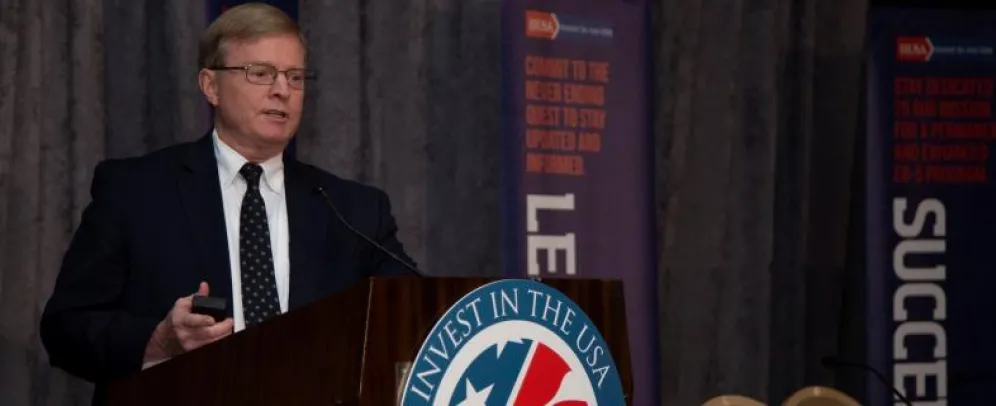Friday, November 20, 2020 - In the wake of COVID-19 consulate closures and reductions of service, more visas are available than ever but few interviews are being scheduled at posts due to ongoing COVID-19 concerns. This has resulted in limited visa issuance. We engaged virtually with Charlie Oppenheim Chief of the Immigrant Visa Control and Reporting Division at the U.S. Department of State (DOS) at the IIUSA Virtual Industry Forum as he presented the data and a glimpse into what this could mean for investors in the queue and those looking to make EB-5 investments in the future.
Public Service Announcement: File your DS-260
Even if your consulate is not open or processing EB-5 applications at this time, if your priority date is current on Chart B of the Visa Bulletin, Oppenheim stressed the importance of doing your part to become documentarily qualified by filing your DS-260 with the National Visa Center (NVC) and having everything ready in preparation for the consulates opening. This will give DOS the best odds to process as many cases as possible.
COVID-19 Impacts on FY2020 Visas
In 2020 USCIS processed 1,177 Adjustments of Status, down only about 25% from FY2019. However, the real story is that the consulates issued only 2,425 immigrant visas due to COVID-19 - down approximately 70% from FY2019, for a total of only 3,602 of the 11,000 annual EB-5 visa limit for FY2020, wasting just under 7,400 visas.
Extra Visas in 2022?
Great News! The family category could again have additional unused visas. Absent congressional action, those visas will again be added to the employment category in FY2022. The annual visa limit for all employment-based categories could be in excess of 200,000 in FY22. EB-5 is entitled to 7.1% of the worldwide level, equivalent to about 14,200 visas.
“For China, the future is promising. I think the future for other countries, is extremely promising, based on this year’s limit and what is likely to happen next year.” - Charlie Oppenheim

India
India has a large population of applicants already living in the United States who are Adjusting Status (I-485). This could serve to benefit Indian chargeable investors, as consulates remain closed. With India current, on Chart A of the Visa Bulletin, all those Indians who are currently in the USA, eligible for adjustment of status, have an opportunity to obtain visas, realizing their allocation. We encourage you to file now if you are eligible.
The other good news for Indians is that despite COVID19, Indian applicants received over 600 of their 770 visas in FY2020, wasting few visas. Today, there are only 799 applicants with NVC thus, with 1,300 visas, India should have enough visas to remain current on the Visa Bulletin (depending on the number of adjustments pending at USCIS, which are unknown).
Vietnam
Vietnam will see a slight advancement in final action date in the December Visa Bulletin from a priority date of August 15, 2017 to September 1, 2017. Due to COVID-19, Vietnamese applicants received only about 450 of their 770 visas in FY2020. NVC currently has about 1,662 Vietnamese chargeable applicants. If the consulate opens and they are able to use all 1,300 visas this year, this could make a 23% reduction in their 5,499 applicant backlog. Oppenheim estimates a 7-year wait for visas.
Brazil, South Korea, Taiwan
Great news! Oppenheim is still anticipating all 3 countries will remain under their limit, with no wait for visas.
China
In addition to the estimated 2,500 I-485 pending with U.S. Citizenship and Immigration Services (USCIS), The Department of State has approximately 8,000 Chinese already documentarily qualified, but with the US Consulate in Guangzhou (GUZ) offering extremely limited visa services at this time and no announced plans to resume, unfortunately the Department of State will not be advancing the final action date for China-mainland born applicants on Chart A of the Visa Bulletin in December and it is unlikely in the foreseeable future. The positive news is that as of November, Chart B is still open for Adjustments of Status (AOS). Thus, those with priority dates earlier than December 15, 2015, who are currently in the USA, eligible for AOS, have an opportunity to obtain visas. We encourage you to file now if you are eligible.
While Oppenheim did share his estimated wait time for China - 17.2 years, I think given the number of variables (dissipation, revocation, death, birth, age out, withdrawal, legislation, extra family visas, COVID consulate closures, rest of world visa usage, etc.) and wide variance, it is essentially impossible to estimate at this time. What I understand with some confidence is there are about 57,000 visa applicants currently in the queue. If China received 100% of the 18,560 visas this year and 10,000 visas each subsequent year, it would take under 4 years to eliminate the current backlog. If China were to only get the minimum 700 visas per year, it could take 81 years. Both are highly unlikely extremes. More realistically, if China goes back to getting about 7,000 visas per year, as they historically did before the Boom, we could be looking at about 8 years. Oppenheim’s worst-case scenario estimate of 17 years amounts to about 3,300 visas (which I think is conservative).
Hong Kong
Oppenheim also confirmed, as the Visa Bulletin alludes, Hong Kong continues to be viewed as a separate foreign state. This means it continues to receive its own visa quota, separate from the China visa quota, which is currently subject to huge visa backlogs.
